A wallet is an app for generating, managing, and storing cryptographic keys - your public and private keys.
You can check your balance, receive, and send funds with a wallet. Wallets generally don’t allow you to buy cryptocurrencies; that is what exchanges are for. All exchanges provide you with wallets to store your coins in after you buy them, but wallets usually don’t provide you with an exchange service.
A wallet generates a random private key, sk, derives your public key, pk using elliptic curve cryptography and derives your address(es) from your public key. A wallet then stores your private key(s) and takes care of signing transactions.
In this article, we want to give you an overview of what types of wallets there are and help you find the right wallet for you. We show you how your mnemonic phrase is generated, and how it relates to your actual private key. Depending on the wallet implementation, the process for generating your address from a private key looks slightly different. We also look at multisignature schemes, where multiple private keys and digital signatures can spend money from a given address.
What Does a Wallet Do?
A wallet is a program that has three main functions:
- Generating, storing and handling your keys and addresses
- Showing you your balance
- Creating and signing transactions to send funds
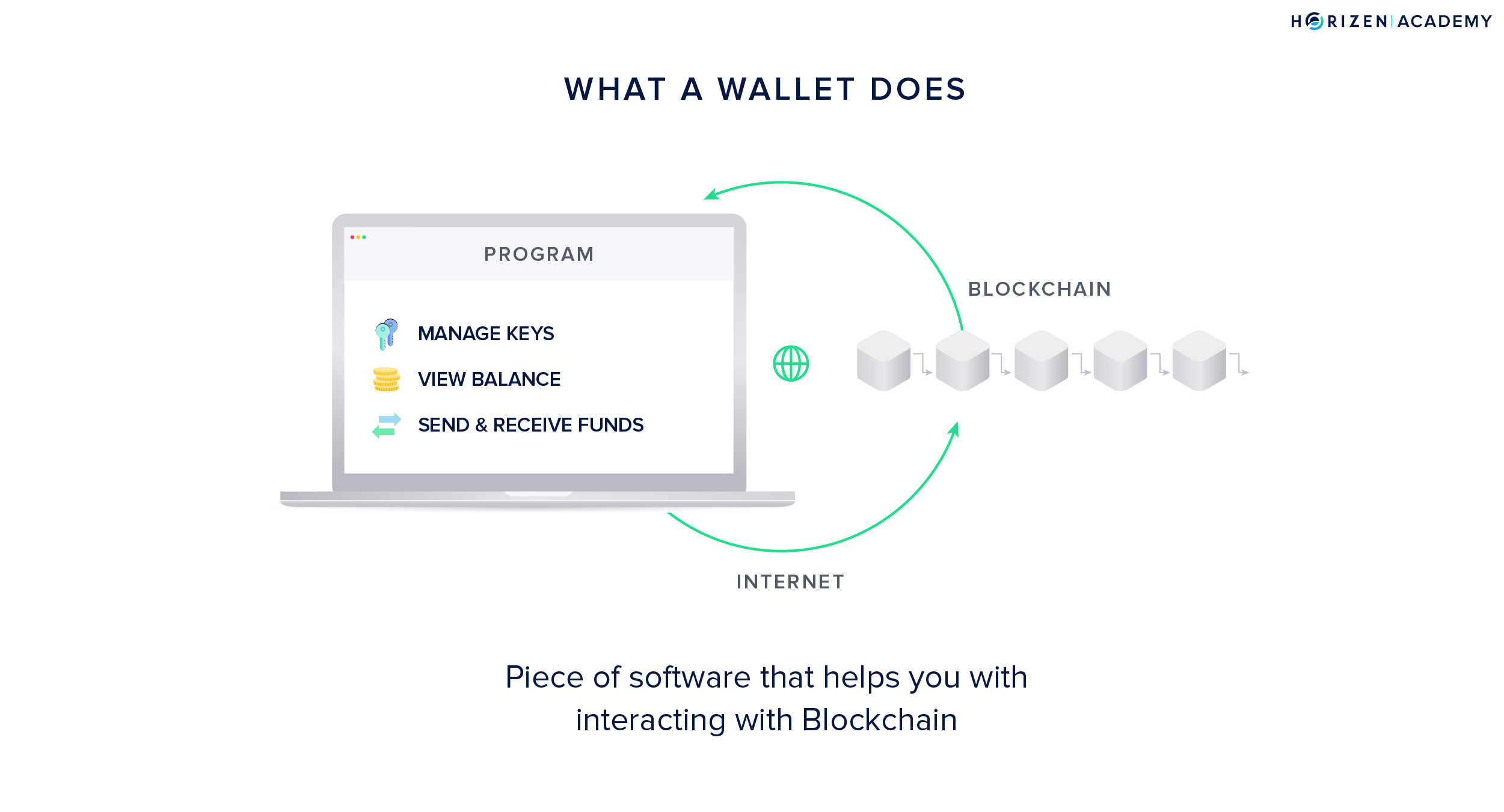
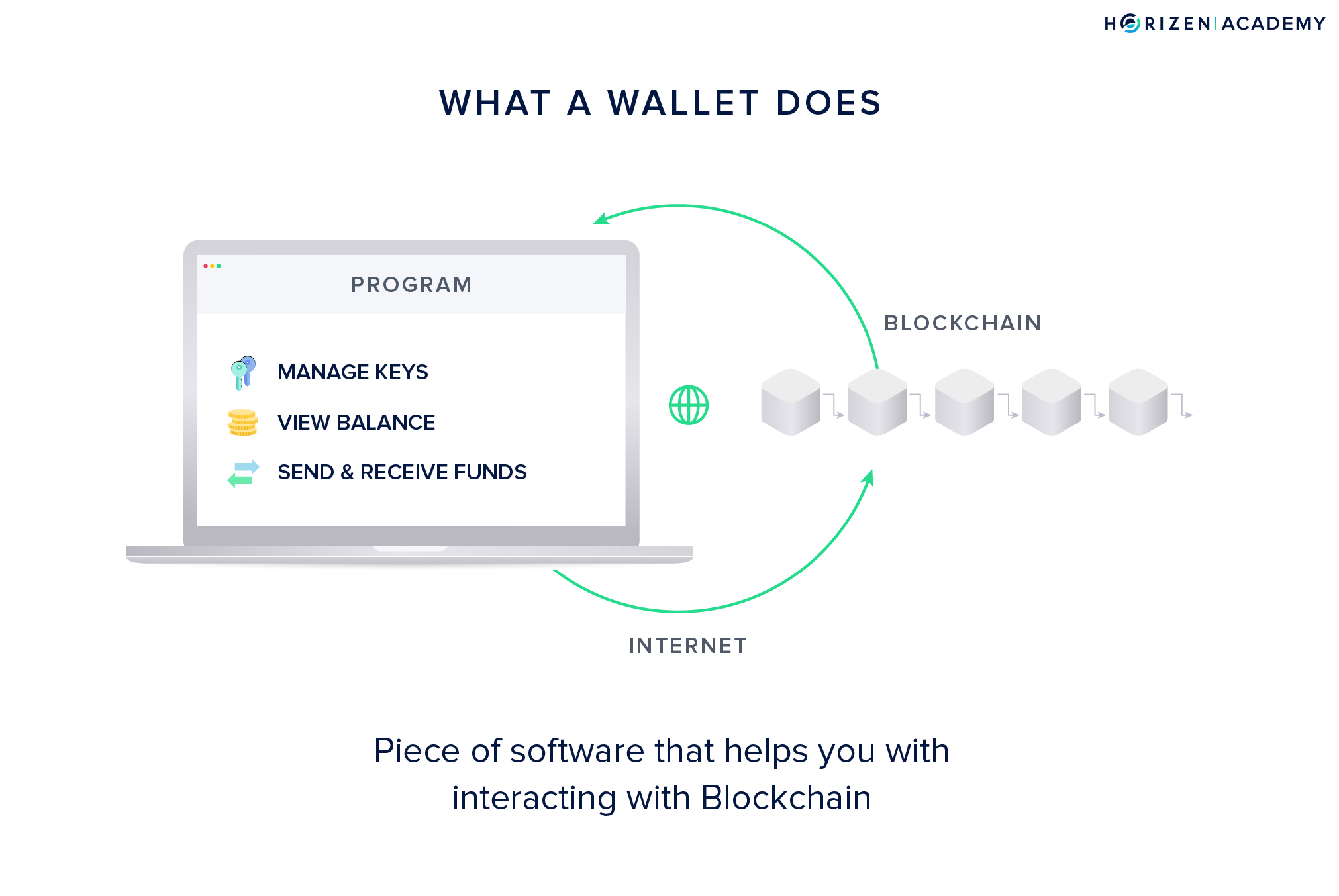
The first function is the primary function and main differentiator of all wallets: generating, storing, and handling your keys. Having access to your private keys means being able to spend your money.
Where you store your keys determines the safety of your funds and at the same time, the convenience of using them. With wallets, there is usually a trade-off between security and convenience: Having some funds in your mobile wallet on your smartphone makes them easy to spend, but not very secure. Keeping larger amounts of money on a hardware wallet is very secure, but not as convenient when you want to spend it.
A Wallet Acts as a Keychain
Although the term wallet might be more intuitive, the function of a wallet is closer to that of a keychain rather than an actual wallet.
To make it crystal clear:
You don’t actually store any cryptocurrency in your wallet. You just store the keys to access them on the blockchain.
The blockchain records the amount of coins associated with a key pair, your identity on the blockchain. It calculates the amount of money the keys have access to based on all the transactions on the blockchain.
The main function of a blockchain is to store all transactions in the correct order. If you receive 10 ZEN in a transaction and receive another 10 ZEN later on. It is clear that you, the owner of the key pair, owns 20 ZEN.

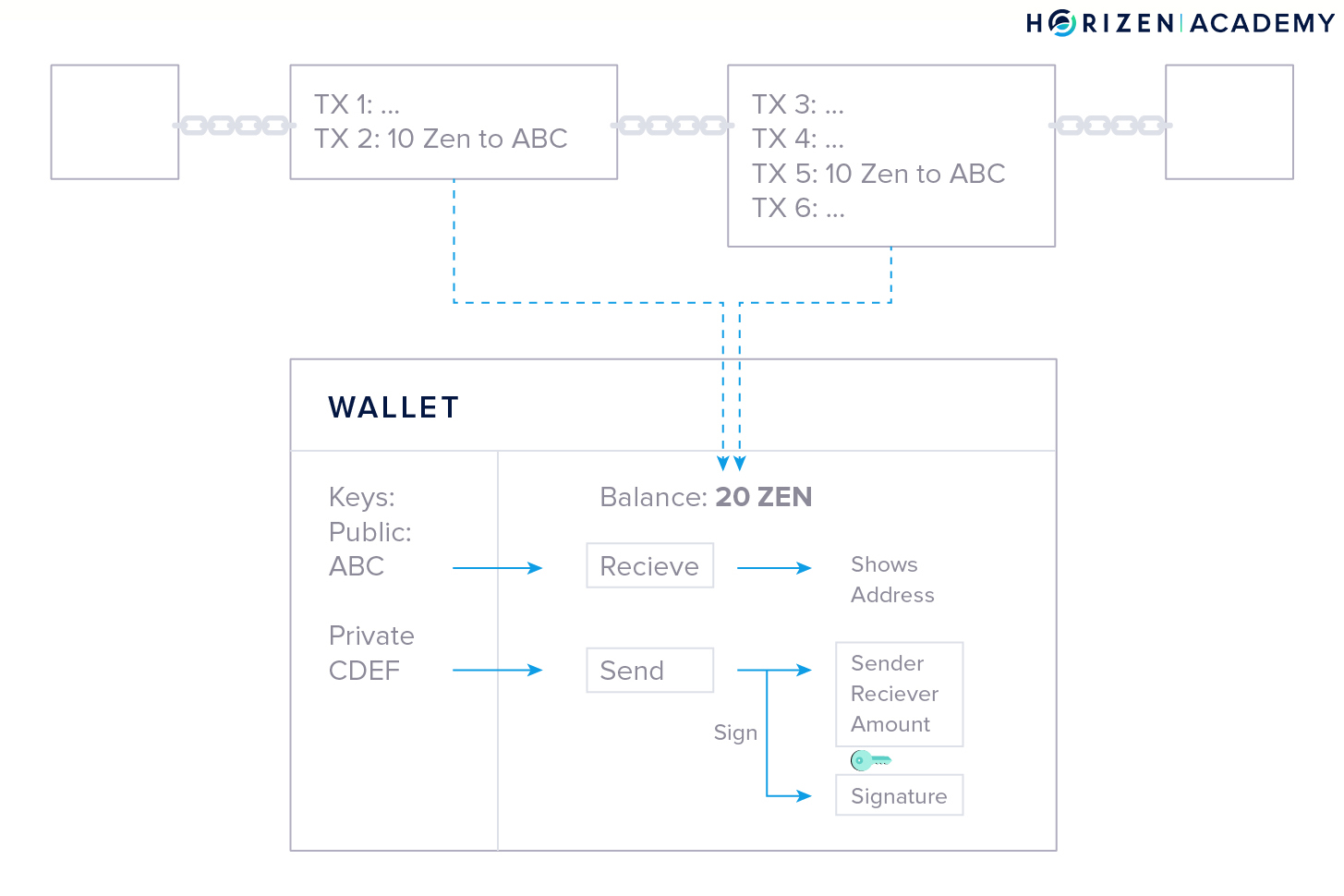
To spend your money, you need the private key stored in your wallet. This is why a keychain is a good analogy for what a wallet does. If you don’t control your keys, you don’t control your funds. You don’t need to understand how public-key cryptography works in detail in order to use cryptocurrencies, but the concept of your keys giving you access to your funds is still important to remember.
Wallets create a layer of abstraction and are becoming more and more user-friendly. Wallets show you your balance, generate an address to receive funds by just clicking “deposit” or “receive”, and provide you with a simple interface to send funds. All you need to do is enter the address that you would like to send money to and the amount you want to transfer. The signing procedure using your private key will happen in the background when you click send.
Transactions
A transaction is when you send money to someone else. When you create a transaction, you send a message to the network that some of your money now belongs to somebody else. The blockchain records this message.
For example, Alice could send one ZEN to her friend Bob. Alice will send a message to everyone on the network that she just sent Bob one ZEN.
When Bob wants to spend that one ZEN, he will create a new message to the network. This message will say: “I received one ZEN from Alice and I am sending that one ZEN to someone else now”.
This is how money is sent from one person to another without the help of a central third party.

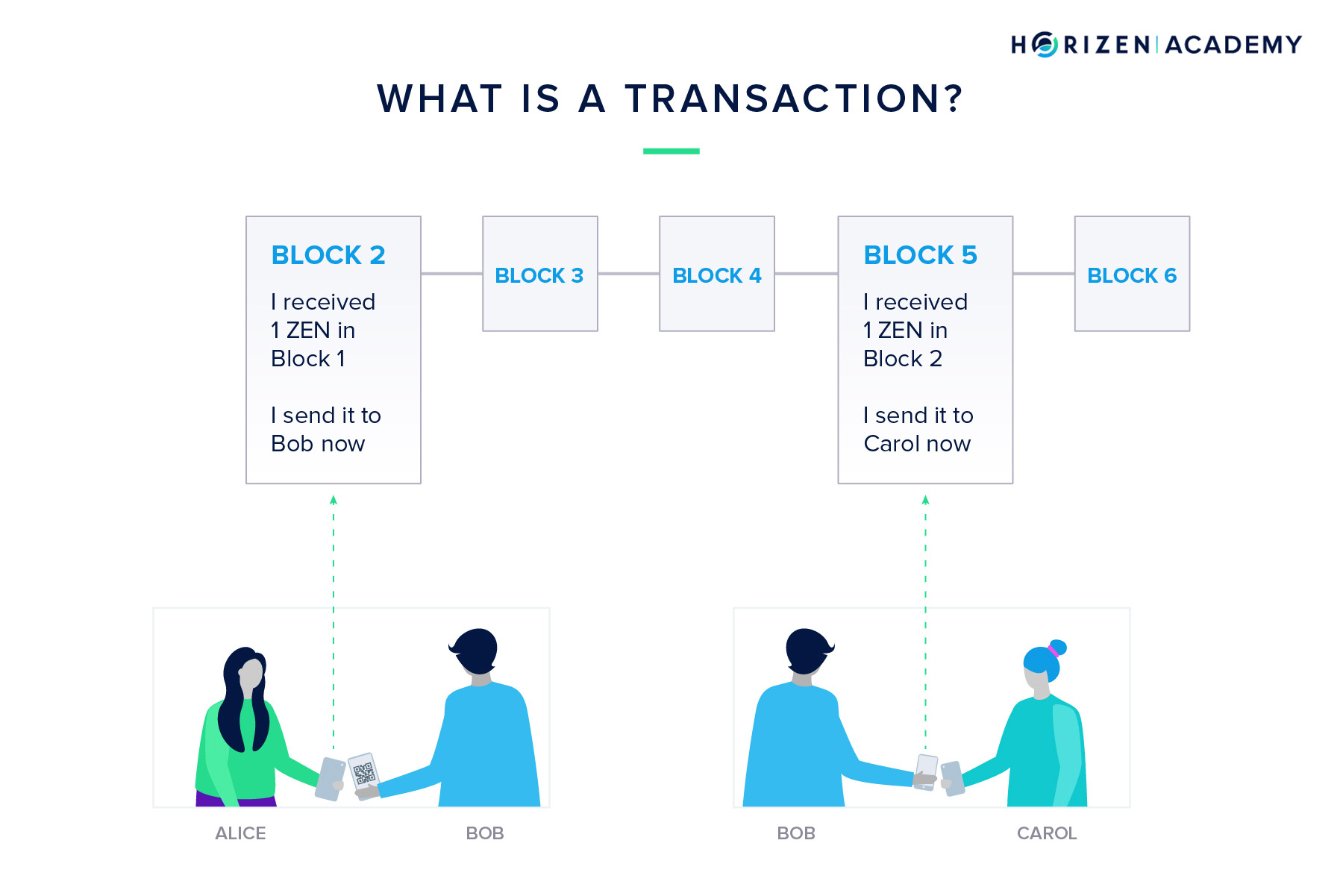
A wallet gets your balance from monitoring the blockchain for any transactions that involve your address. Initially, all transactions are cryptographically locked. The lock is based on the address the transaction is sent to, and can only be unlocked with the corresponding private key.
Let’s assume this is your wallet. You received a total of 20 ZEN in two different transactions of 10 ZEN each. Now you want to spend 2 ZEN at lunch. Your wallet starts with a blank transaction and, in a first step, chooses one of your prior transactions to spend. In this case, both transactions are of sufficient value, so your wallet might randomly choose the first one.
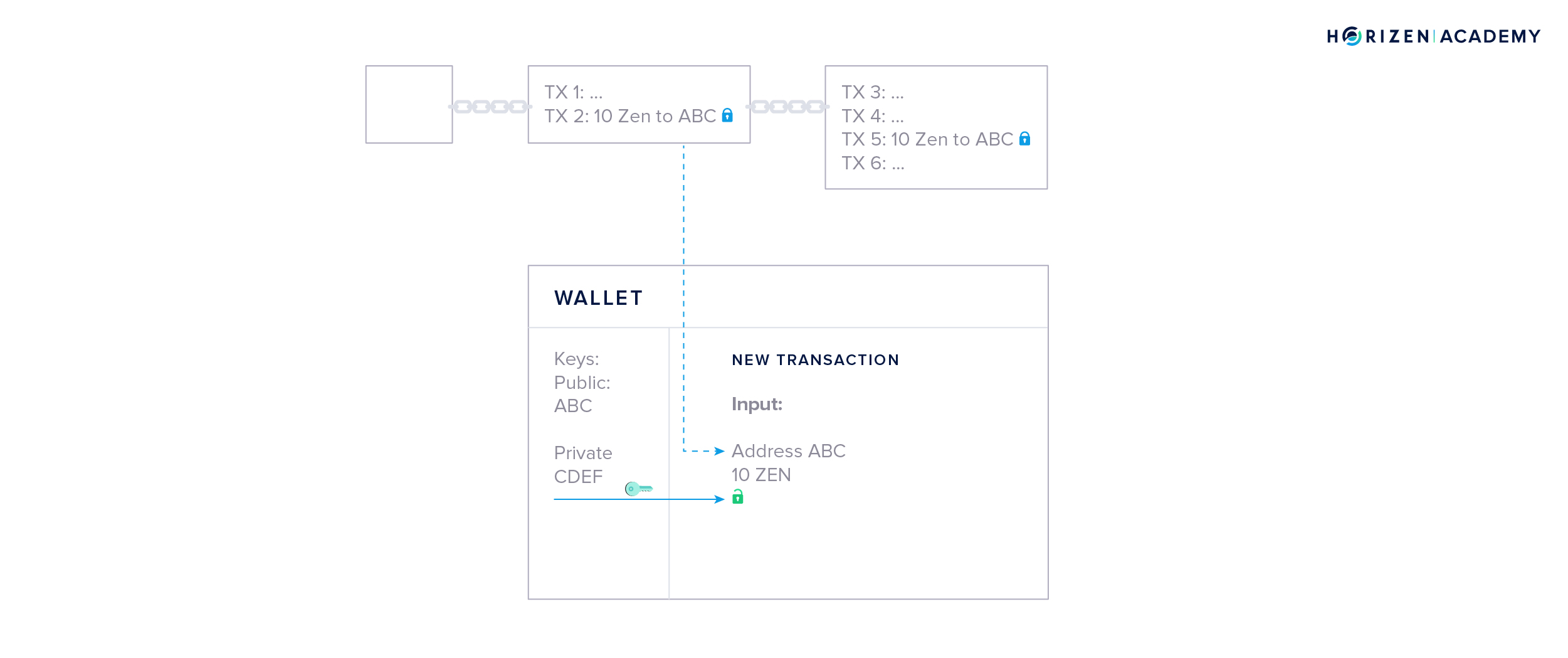
The money that is being spent in a transaction is called the input, and the money that is being received is called the output.
Your wallet places one of the outputs you own in the empty transaction and uses your private key to unlock it, so it becomes spendable - this is what we called signing the transaction. The unlocked output is now used as an input to a new transaction.
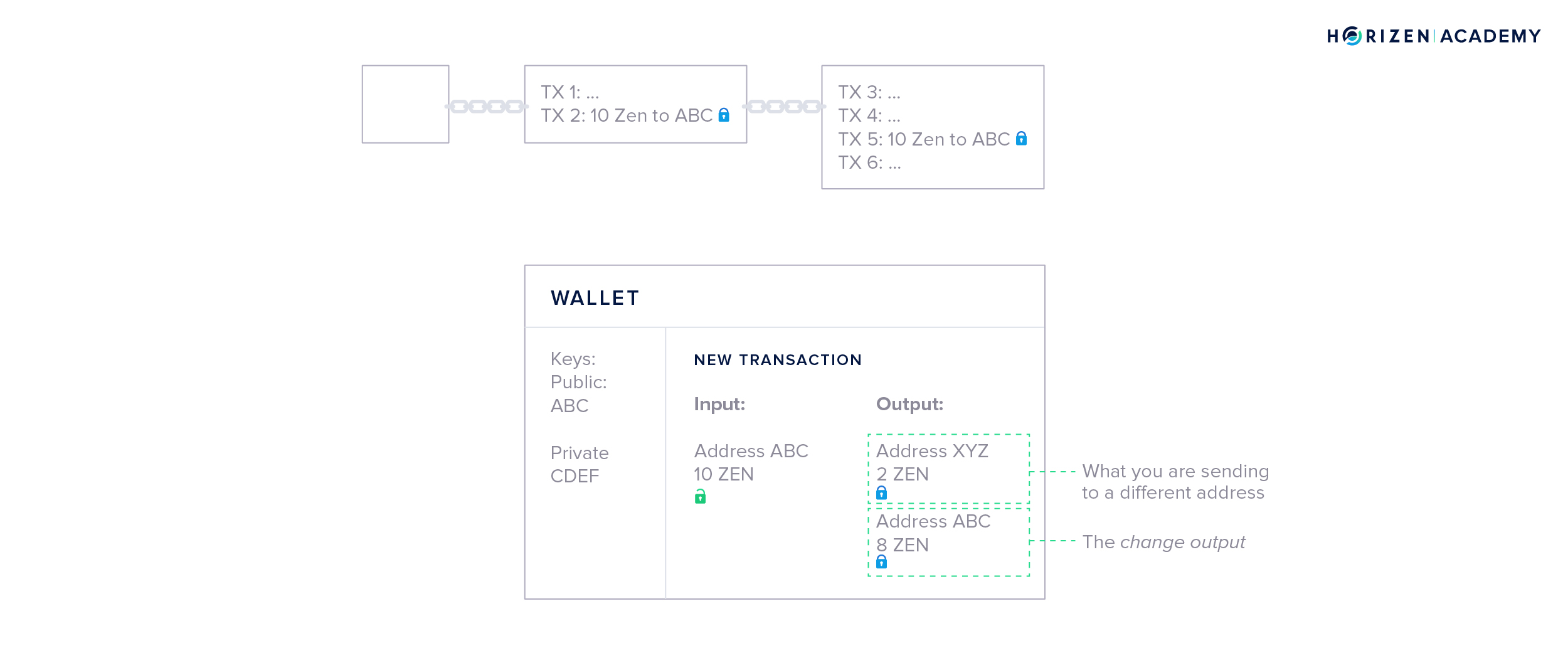
Next, your wallet creates the outputs. It asks you for an address to send money to and an amount. You want to send 2 ZEN to address XYZ to pay for your lunch, so your wallet creates the first output accordingly.
The second output is generated automatically - its called the change output.
Outputs are similar to cash denominations. If you need to pay $2 USD but only have a $10 bill, you expect to get $8 in change. Your wallet automatically includes the change in the transaction. The newly generated outputs are locked by default.
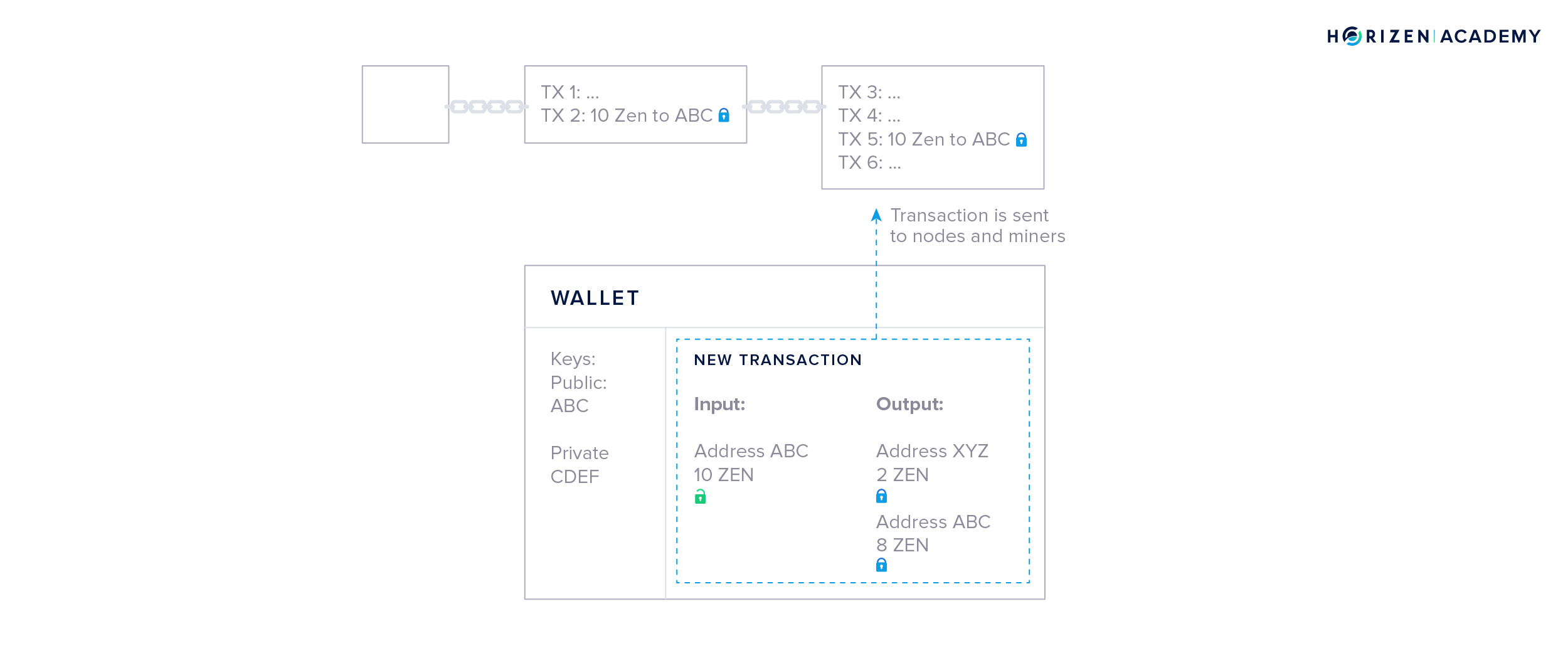
Lastly, your wallet broadcasts the transaction to the network, where all nodes and miners will verify if the signature you used to unlock your money is valid. If it is, miners will include your transaction in the next block. The output of 10 ZEN you used is from now on publicly visible as spent. The newly created outputs of 2 and 8 ZEN are included in a new block and locked - or unspent.
Then you come across the term UTXO - Unspent Transaction Output - this is what it refers to.
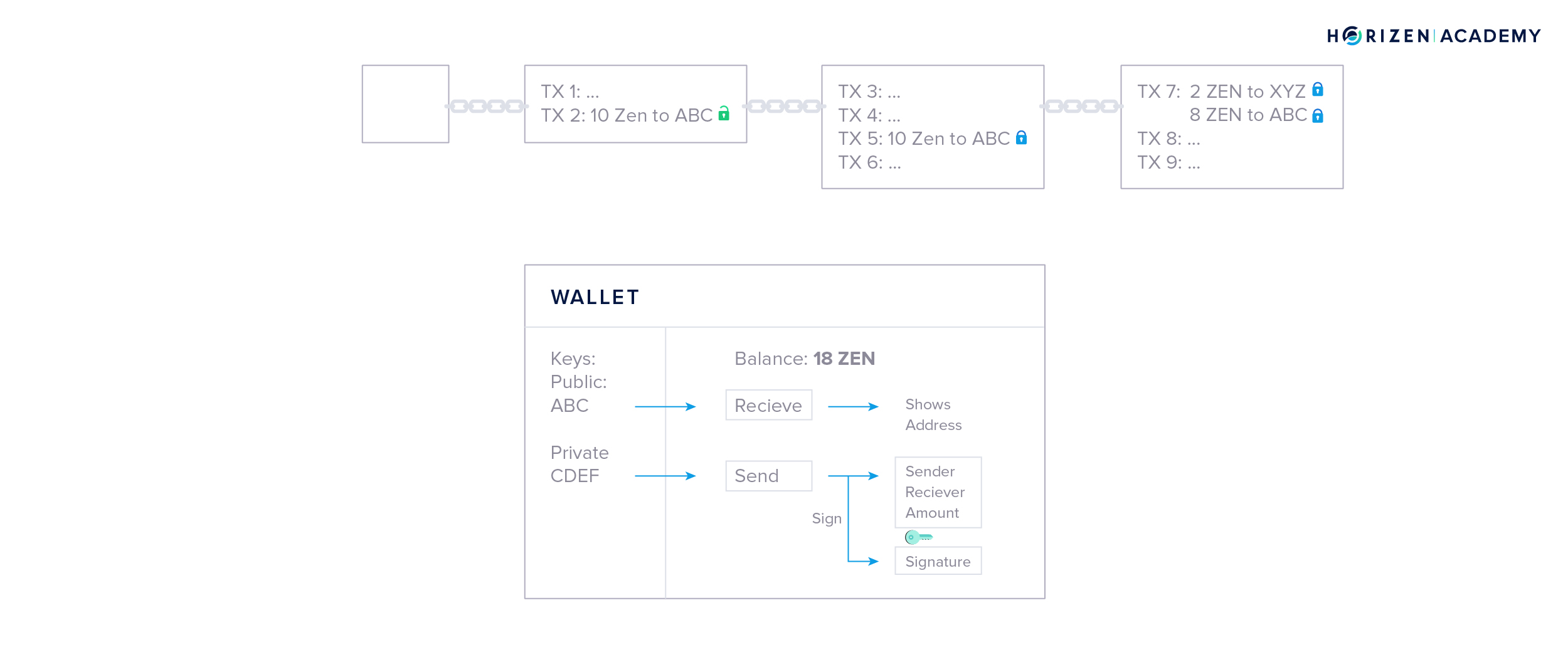
When you own 10 ZEN, it means you received 10 ZEN in a transaction, and you have not unlocked and spent that output, yet.
What if I Lose My Keys?
You don’t have to ask anybody to join the network, and you don’t have to register with a central authority to create a wallet. Being able to do this comes at the cost of you being responsible for the safety of your coins. There is nobody that can help you recover your keys if you lose them.
If anybody were able to recover your keys for you, they would also be able to steal your funds. This would eliminate the trustless aspect of blockchains. You may have heard stories about people searching for old hard drives because they have “lost their Bitcoins”. More accurately, they lost the keys to access their Bitcoin.
But there is a sort of recovery mechanism with many wallets called a mnemonic phrase, or backup phrase. A mnemonic phrase usually consists of 12 or 24 words. With these words, you can recover your keys. You receive your mnemonic phrase when you install and set up your wallet.
It’s essential to understand that your backup phrase is just as important as your private key itself. If anybody gets their hands on your backup phrase, they can access your money. Saving it as a screenshot or text file on your computer is not a good idea!
Types of Cryptocurrency Wallets
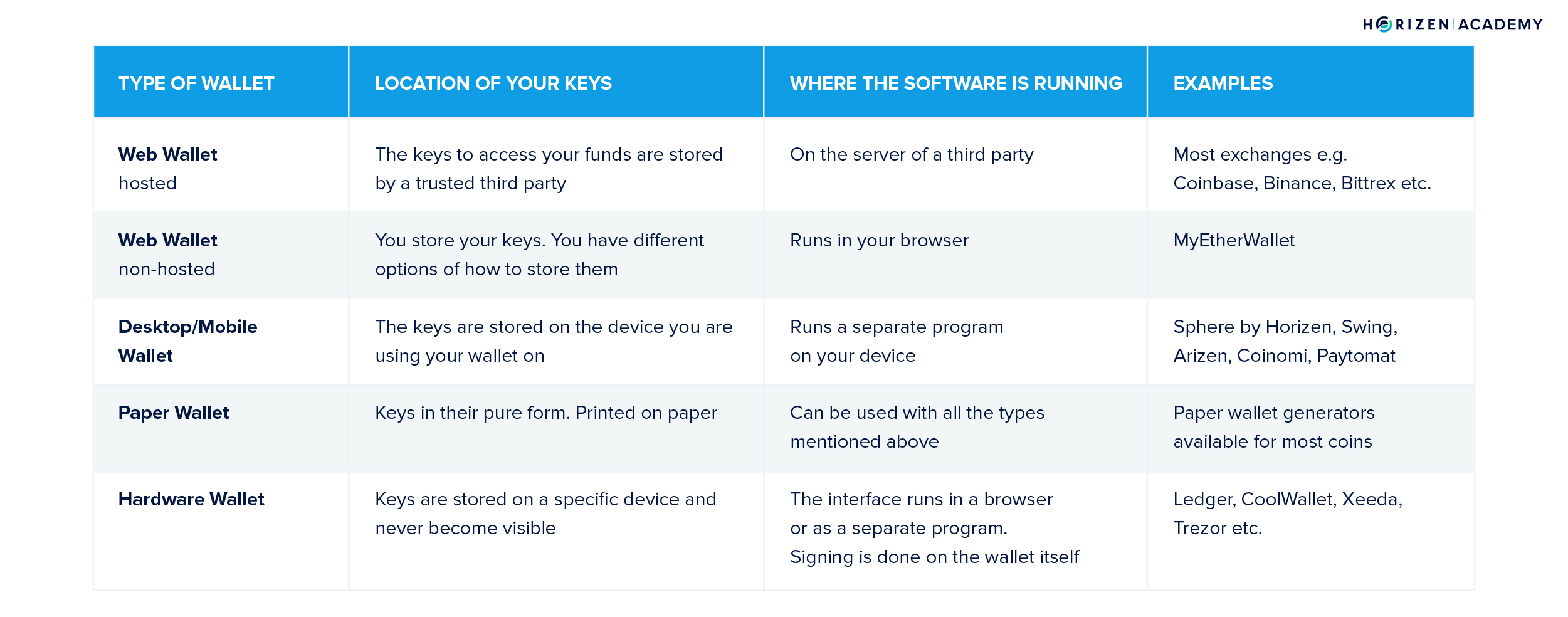
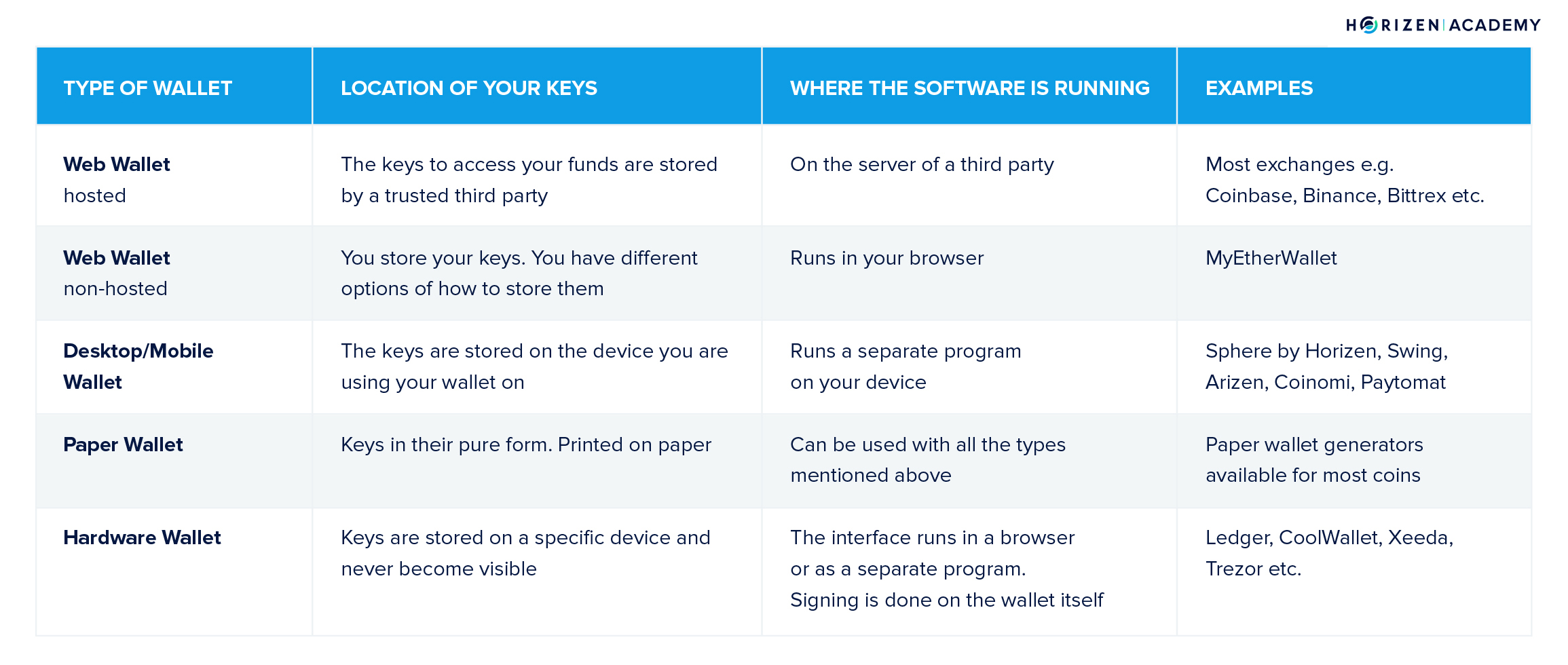
Hosted Web Wallets
We can distinguish between hosted and non-hosted web wallets. With hosted web wallets, your keys are stored online by a trusted third party. These parties are mostly exchanges such as Coinbase, Binance, or Bittrex. When you create an account with these entities, they will create an entry in their internal database linking your account to a set of key pairs for the different coins they have listed.


An advantage to a hosted web wallet is the option to recover your password in case you forget or misplace it. Losing your private keys, together with your mnemonic phrase, leads to a loss of funds in all other cases.
While this may sound reassuring, there are some drawbacks with hosted wallets, which are also called hot wallets or cloud wallets. Remember: if you don’t control your keys, you don’t control your funds. There is always a third party risk, no matter how trustworthy the party might seem.
First, they are a more attractive target for hackers than individuals because their honeypot is much bigger.
Second, a sudden change in regulation might not allow them to allow you to withdraw your funds in a worst-case scenario. It is unlikely, but definitely not impossible.
Third, there is always a chance of an entity going bankrupt or stealing money. With major exchanges like the ones mentioned above, this risk seems small, but it does exist. Just ask former Mt. Gox customers.
For these reasons, we advise everybody to store the keys to their funds themselves. This means storing them in a wallet where you have control over your private keys. There is a responsibility that comes with being in charge of the safety of your funds yourself, but enabling you to do this is one of the main motivations for the existence of cryptocurrencies!
You will need to keep some funds on an exchange if you plan to trade often.
Non-Hosted Web Wallets
Besides hosted web wallets, there is also a range of non-hosted web wallets. One of the most popular non-hosted web wallet is likely MyEtherWallet, which can store Ether (ETH) and all ERC-20 tokens, tokens that are “living” on the Ethereum blockchain. These wallets provide an interface to check your funds or create transactions in your web browser, but you have to provide the keys with each login.
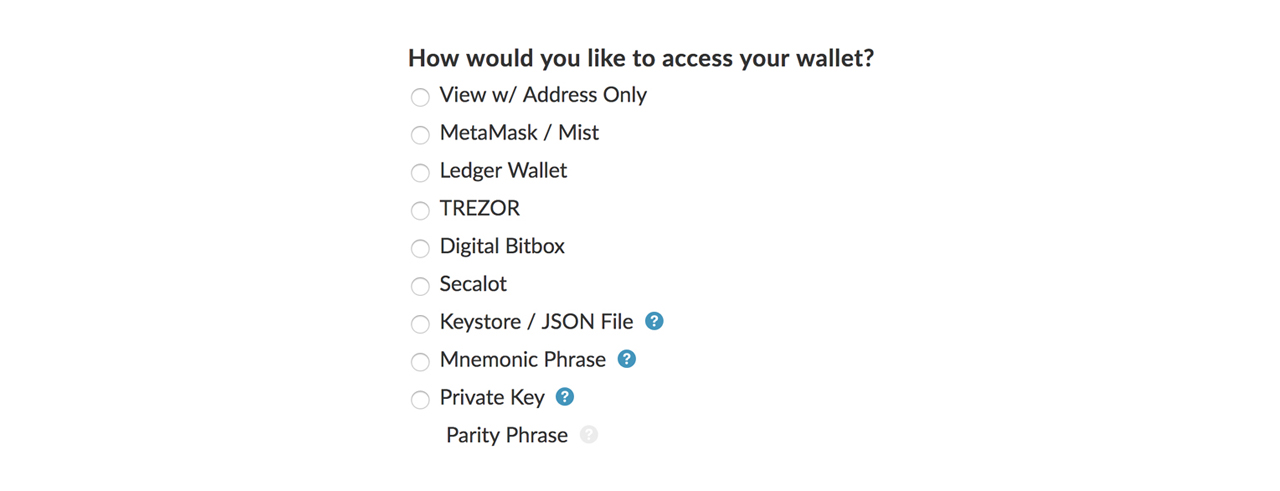
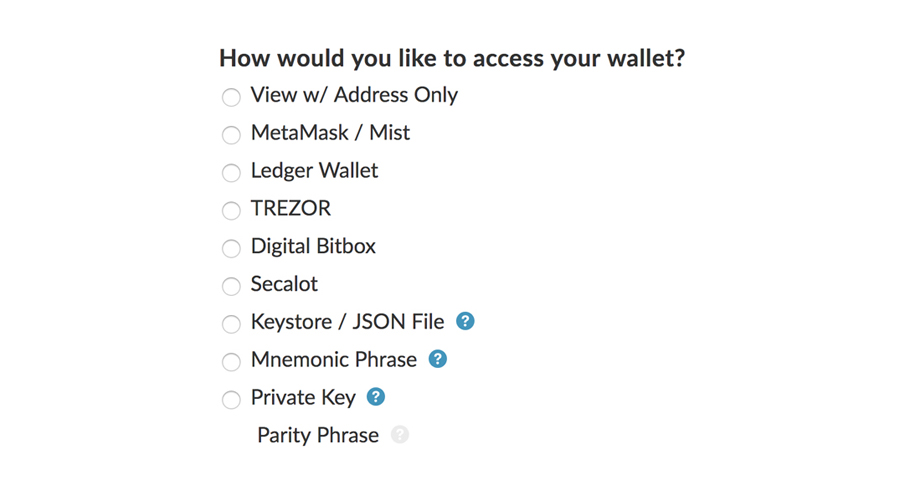
There are a range of options to access your wallet with MyEtherWallet, often abbreviated as MEW. The first option requires your address, but only lets you view your funds.
MetaMask is a browser plugin that provides the option to make ETH payments within your browser and the ability to login to MEW. It also provides a function detecting phishing sites and warning you when you are about to open one.
The following options, Ledger Wallet, Trezor, Digital Bitbox, and Secalot are hardware wallets. We will get to those later in the article.
Accessing your wallet with a keystore, or .json file, is possible, but not recommended. The file contains your private key, when you create your wallet, you have the option to download it. If it gets into the wrong hands, they will have access to your funds, so saving it on your desktop is not the ideal solution. If you want to use this method, you should encrypt the .json file and store it on a separate device like a USB drive. To use, connect the drive, decrypt the file, then select the file in your browser and voila. After that, you can disconnect your storage medium of choice again.
The last two options are more or less the same with regards to safety. You can either enter your private key directly or your mnemonic phrase, which yields your private key when hashed, which are both problematic if your machine is compromised.
In conclusion, a non-hosted web wallet is quite convenient and just as secure as the method you choose to provide your keys with.
Desktop Wallets and Mobile Wallets
If you start off with the question “where are your keys?”, the desktop and mobile wallet will give you the same answer: on the device. Phones and tablets are more powerful than ever, the difference between a desktop and a mobile wallet is marginal. It is also arguable whether one is safer than the other.
By now you know the tasks a wallet performs: viewing, receiving and sending. If you want to use crypto for everyday transactions, there is almost no way around keeping some funds in a mobile wallet. As mentioned before, when creating your wallet, you will get a mnemonic phrase that you should keep safe. Usually, there is a PIN, password or Face/Touch-ID protection to access the wallet. You should never keep more funds in a mobile wallet than you are willing to lose.
It’s the same as with cash: you don’t carry around all your money in a wallet. You withdraw as much as you are comfortable handling in cash and keep the rest in your account or under the mattress.
With desktop and mobile wallets, there is a choice between single and multi-currency wallets. Those should be rather self-explanatory terms. The former allows you to store one coin, while the latter supports multiple currencies. Some of the more popular examples of desktop wallets include Coinomi and Sphere by Horizen. For mobile, there are Coinomi, Mycelium or Paytomat, just to name a few.
If you get your first coins on an exchange, I would recommend you transfer your funds out of the exchange from the hosted web wallet, onto a desktop, paper, or hardware wallet. Send a fraction first to make sure everything works as planned. If your first transaction works, then you can send the rest. You are now protected from third-party risk, but have full responsibility for your funds yourself.
Paper Wallets
Referencing our golden thread again and asking “where are the keys” gives you a simple answer with a paper wallet: in your hands! A paper wallet is your public and private key pair printed on paper. Almost every cryptocurrency offers a paper wallet generator. To create a key pair, you generally first have to create some entropy, a term for disorder. In other words: you want your keys to be as random as possible. This is mostly done automatically, but sometimes you will find features where you have to randomly move your mouse or hit keys on your keyboard to create randomness.
When printing your paper wallet, you should not use a shared printer, like the one in your office. In a best-case scenario, the printer doesn’t even have an internet connection. Printers usually keep a copy of the files they printed last, and an attacker might exploit this.
You will end up with something looking like this after printing the wallet.

There is only one thing left to do: send your coins to the public key. After that, you have a perfect long term storage solution for your coins. The main risk with a paper wallet is you actually losing or destroying the wallet by accident. If you don’t have a mnemonic phrase to recover the private key, you are at risk of losing all funds on the wallet. So choose wisely where to store your paper wallet. Print several copies if you feel uncomfortable having only one and store all of them in separate, safe places.
Hardware Wallets
Moving on to everybody’s darling: hardware wallets. With a hardware wallet, your keys are stored on the device in something called the secure element. The secure element is a place to store data, in this case your keys, that cannot be directly accessed by your computer or any other device even when it is connected.
Although it does look like a simple USB drive, it can actually do more than just providing storage for your keys. To use a hardware wallet, you usually have a few options of which interface to use. Like MyEtherWallet, a few other wallets offer hardware wallet support. Additionally, you have the native wallet apps provided by the producer. In the case of Ledger, for example, the native app is called Ledger Live.
How Does a Hardware Wallet Work?
The interface generates an address when you want to receive funds. Using this feature is pretty straightforward: if you click the receive button, the process runs in the background and the address is displayed for you to share with the sender.
If you want to send money, the app creates the raw transaction that needs to be signed. The unsigned transaction is now sent to your hardware wallet, where it gets signed with your private key. The signature is then returned to your computer and the complete transaction, including the signature, is broadcasted to the network.

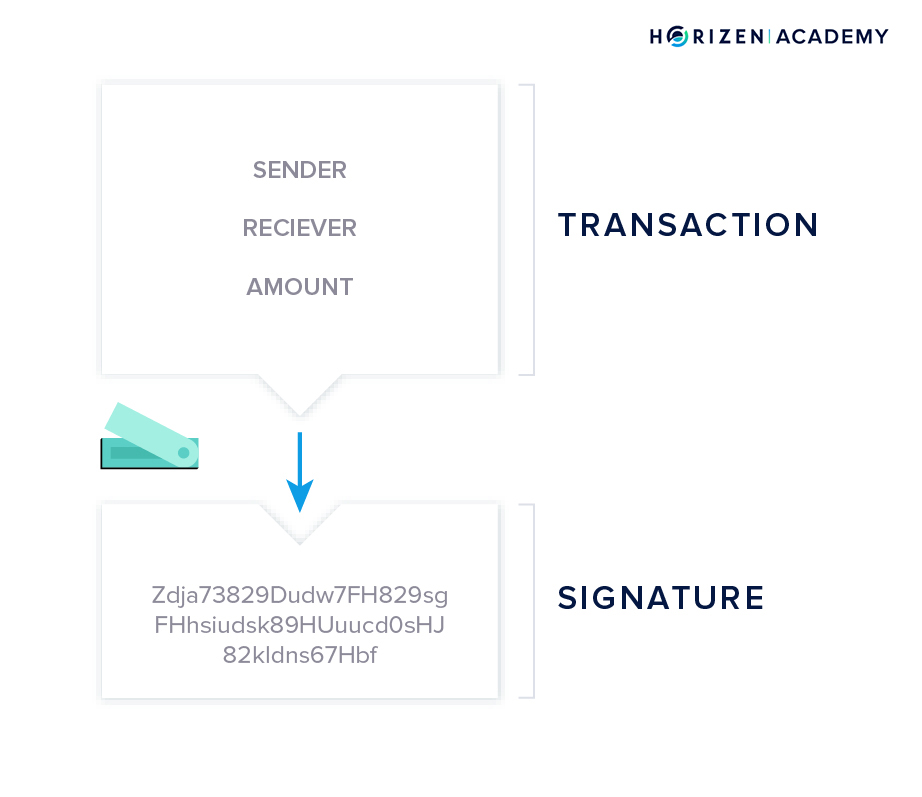
Your private key(s) do not leave the device, so they are not visible to the computer you are using your hardware wallet with at any time. This is why a hardware wallet is considered the most secure way of storing crypto, especially large amounts.
If your device ever breaks, you have your mnemonic phrase as a backup. At the risk of being repetitive: your mnemonic phrase, under all circumstances, must stay private and in a secure location. A copy at a trusted family member or in a bank vault might be a good idea in case of a fire or flood.
Generating Entropy and a Mnemonic Phrase
The basis for generating keys and addresses is randomness. Ownership on the blockchain is highly secure, as long as the private key cannot be reproduced by an adversary. The private key is the basis of the public key and address(es). As such, it requires a high level of security, and needs to be generated from a high level of entropy.
There are different sources for entropy, such as hardware, user input, microphone, and camera inputs. Preferably, some of the entropy is hardware based and uses more than a single source. Human based entropy is usually less random and therefore less secure.
The initial entropy is used as a seed for a deterministic random bit generator (DRBG), also called pseudorandom number generator (PRNG). DRBGs should be standardized and validated. One example for a vetted algorithm is the NIST SP800-90A compliant method. The deterministic random bit generator produces a seed, which we then use to generate your mnemonic phrase.
Your Mnemonic Phrase
Your mnemonic phrase is a backup of your private key that is used by most wallets. It is a list of random words given to you when creating a wallet. If you break or lose a device with a wallet - no matter if mobile, desktop or hardware wallet - your mnemonic phrase is usually your last line of defense against a loss of funds.
This implies that any attacker that gets their hands on your recovery phrase will be able to do the same. Therefore, you must protect your mnemonic phrase as well as you would protect your funds themselves. You should write the phrase of words down on paper or save them in any analog format you see fit.
The mnemonic phrase mechanism that you are likely familiar with was introduced with the Bitcoin Improvement Proposal 39, or BIP-0039. A mnemonic phrase uses commonly known words, which are used to provide a less error-prone backup mechanism than writing down your private key in a format like base58, hexadecimal, or binary.
In total, there are 2048 words a mnemonic phrase may comprise, each of them unambiguously identifiable by its first four letters. Similar words or different versions of the same word are not included, for example, build/built or woman/women.


The process for generating your personal mnemonic goes as follows:
- First, a multiple of 32 bits, between 128 and 256 bits total, is generated. Let’s use an example with a 256-bit seed.
- Second, a checksum is calculated by SHA256-hashing the seed. The first x bits of the checksum are appended to the end of the seed and x is the number of initial bits divided by 32. Using a 256-bit seed, this results in an 8 bit checksum.
- Third, the concatenated bits are split into groups of 11 bits each. We get 24 groups for our example.
- Fourth, each 11 bit group is “translated” into the corresponding word from the list of mnemonic words. 11 bits can encode the values between 0 and 2047, each matching a word in the list of 2048 words.
Now that we have a mnemonic phrase, it needs to be converted into a binary seed. The PBKDF2 function takes the mnemonic phrase as the password and the string mnemonic + passphrase as the salt. PBKDF2 takes this input and applies a pseudorandom function - here HMAC-SHA512 - to it, in this case 2048 times. The final output is the derived seed of 512 bits length. This seed can now be used as an input for different key derivation methods, such as the hierarchical deterministic key derivation.
Key Derivation
Going forward, we’ll use the term key generation to refer to the random generation of private keys and key derivation to refer to the path from a private key to the public key and an address.
There are instances when it is desirable to be able to generate different addresses from a single seed or private key. By using a new address for each incoming transaction, as well as to change outputs, your privacy is enhanced because it becomes harder to link transactions to a single user. There are different approaches to get those addresses.
One could go through the entire process of key generation and derivation for each address, but this would require the user to keep backups for each individual key. This approach is called non-deterministic key generation. While this approach mitigates the risk of losing all your funds at once in the case you lose a private key and/or mnemonic phrase, it certainly makes for a bad user experience.
Being able to securely produce several child keys from a single parent key creates a better UX in basic wallets, and also allows multi-currency wallets to be backed up with a single mnemonic. This single mnemonic derives a key pair for each chain.
Hierarchical Deterministic Wallets
Hierarchical Deterministic Wallets were introduced with BIP-0032. The general idea is to take a master private key and use it to generate multiple secure child keys.
Before we dive into different key derivation methods, we need to introduce a concept we’ve omitted thus far. The 512-bit seed we obtained from our mnemonic phrase by applying the PKKDF2 function is split into two parts: a zero-level private key and a 256-bit chain code cc.
The chain code is used as a key to the HMAC-SHA256 pseudorandom function that takes two pieces of input, the data and a key, to produce a single 512-bit output. The HMAC-SHA256 function is used at several steps in the key derivation process.
To recap what we did thus far:
- We generated a random bit sequence and used it as an input to a deterministic random bit generator that produced a seed.
- From this seed, we generated a mnemonic phrase, which in turn was converted into a 512-bit binary seed.
- We split our seed into the zero-level private key \(sk_0\) and the zero-level chain code \(cc_0\). A zero-level public key \(PK_0\) is generated from \(sk_0\) using elliptic curve cryptography
Hardened vs. Non-Hardened Secret Key Derivation
When looking at the key derivation in HD wallets, we can generally differentiate between hardened secret key derivation (HSKD) and non-hardened secret key derivation (NSKD). The difference lies in the inputs used to generate first-level keys.


Additionally, we need to introduce the variable i at this point. It is a 32-bit integer that is used to derive different keys with index i from a single zero-level key. By convention, the total range of possible values of i is split between HSKD and NSKD, giving both methods the option to create 2147483648 different first-level keys from a single zero-level key.
The hardened secret key derivation takes the zero-level private key \(sk_0\), the zero-level chain code \(cc_0\) and the integer i as an input. By convention, the top of the integer range, from \(2^{31}\) to \(2^{32}-1\), of i, is used for the hardened secret key derivation method.
In other words, using the HSKD method, the first-level private key \(sk_1\) is a function of three values:
\[sk_1 = HSKD(sk_0, c_0, i)\]The non-hardened secret key derivation (NSKD) additionally takes the zero-level public key \(PK_0\) into account. In the non-hardened secret key derivation method, i will by convention take on values between 0 and \(2^{31}-1\), so the lower half of the total range of i.
In other words, using the HSKD method the obtained first-level private key \(sk_1\) is a function of four values:
\[sk_1 = NSKD(sk_0, PK_0 c_0, i)\]Hardened Secret Key Derivation (HSKD)
The core function that the key derivation is build around is the hash-based message authentication code (HMAC). It is a specific type of message authentication code involving a cryptographic hash function and a secret cryptographic key. It always uses some hash function, which is then appended to name the exact function. In this specific case, the SHA512 hash function is used and the message authentication code is called HMAC-SHA512. HMAC consumes several inputs. For our purposes we group them into two: the key and the data.
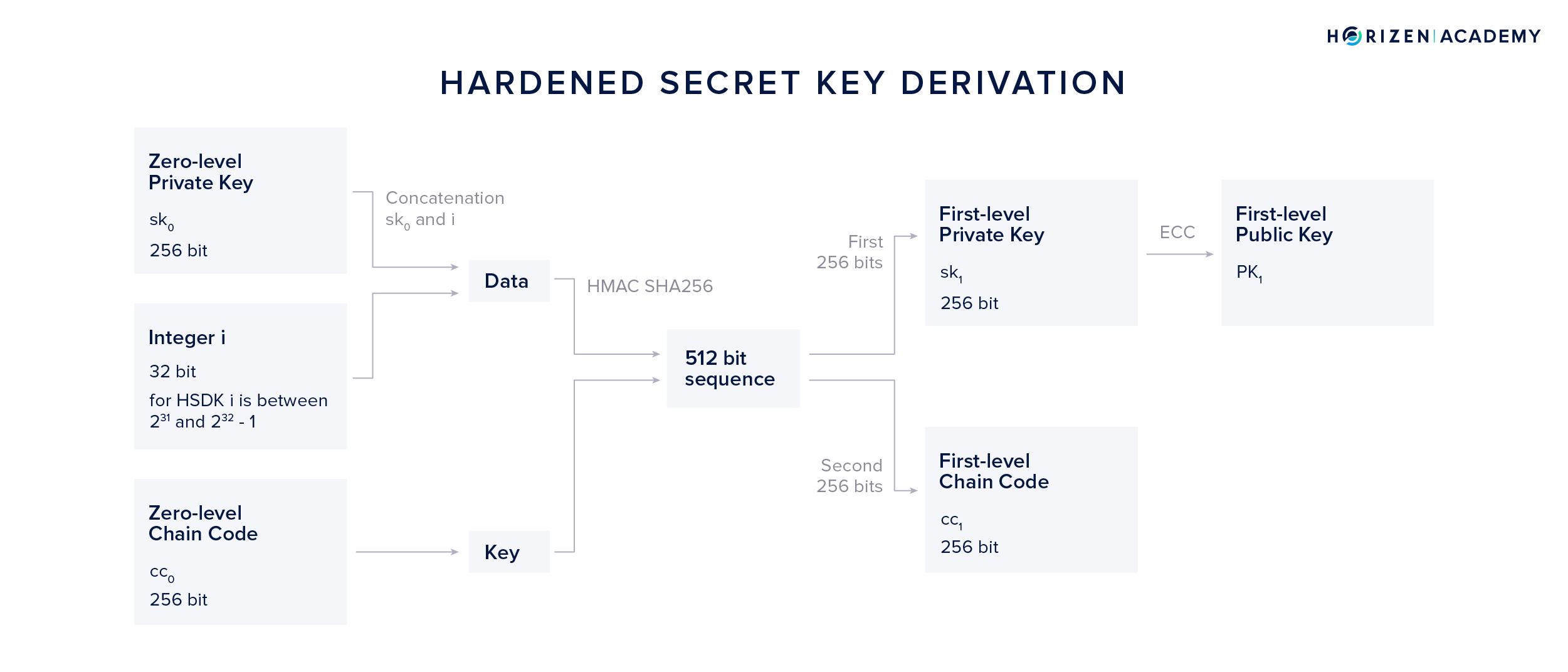
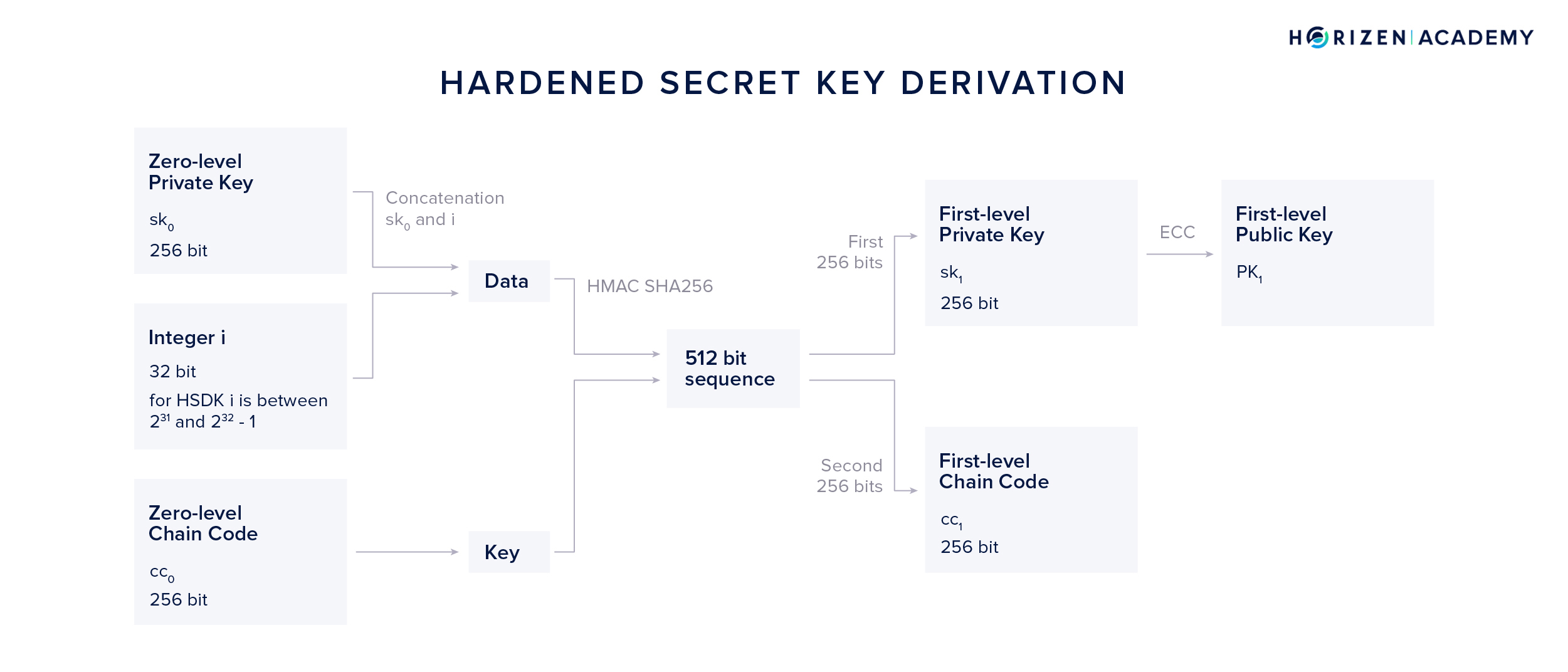
For the HSKD method, the concatenation of \(sk_0\) and our variable integer i is used as the data and the zero-level chain code \(c_0\) as the key.
The resulting 512-bit output is split into two parts of 256 bits each. The first half becomes our first-level private key \(sk_1\), the second half our first-level chain code \(cc_1\). By applying elliptic curve cryptography to \(sk_1\) we can obtain our first-level public key \(PK_1\).
By incrementing i we can generate \(2^{31}\) or 2147483648 different first level private keys and chain codes.
Non-Hardened Secret Key Derivation (NSKD)
We can also derive a first level private key using a combination of our zero-level public key \(PK_0\), zero-level secret key \(sk_0\) and our zero-level chain code \(cc_0\). This method is called Non-Hardened Secret Key Derivation (NSKD).
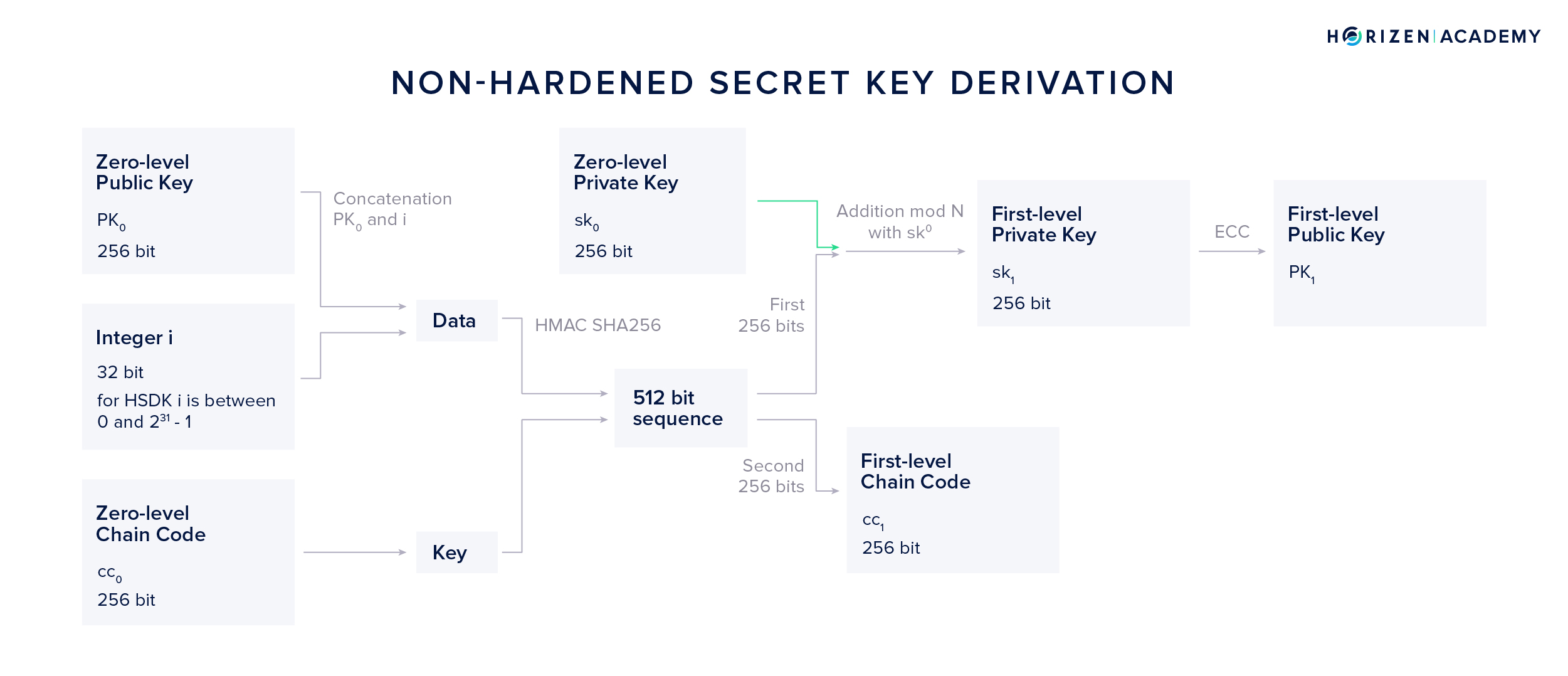
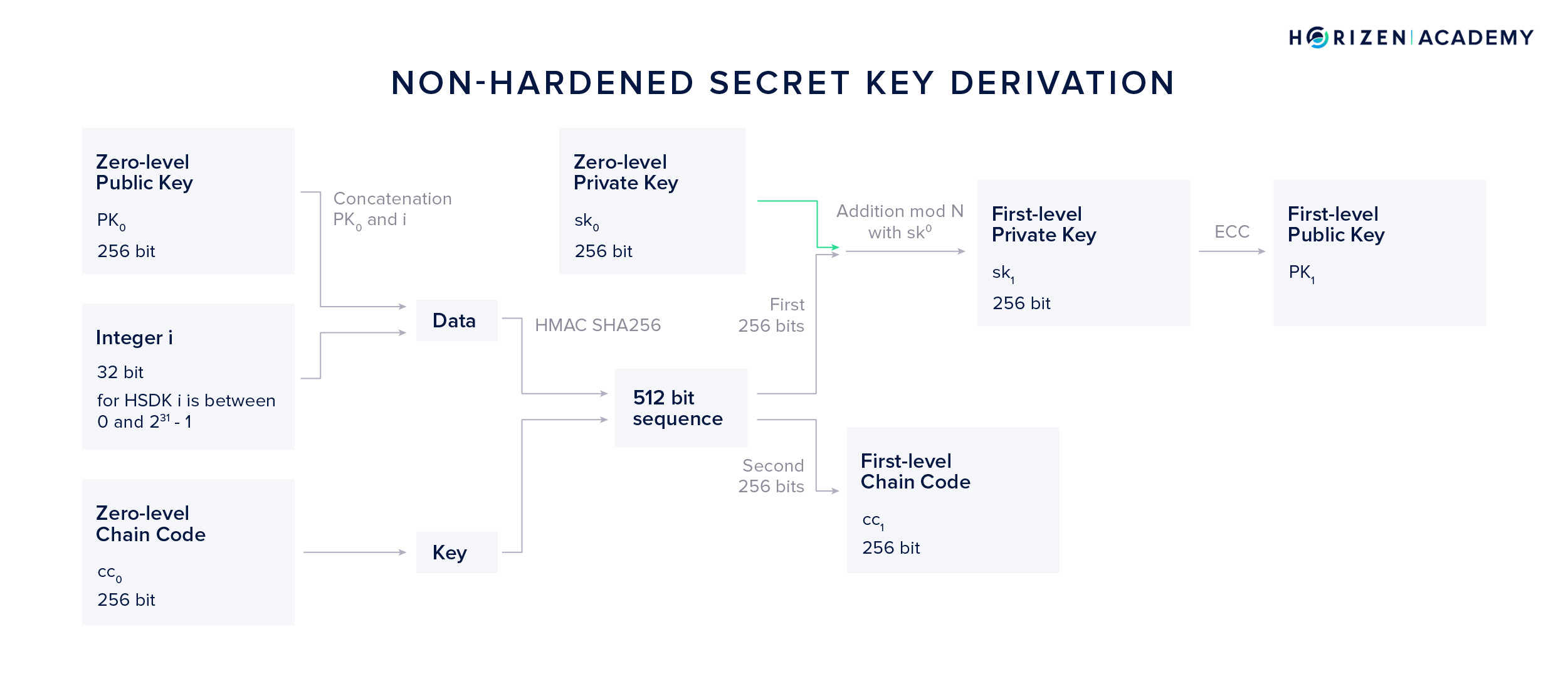
Again, we will use the HMAC-SHA256 function, but this time we use the concatenation of \(PK_0\) and i as out data and once again \(cc_0\) as our key. Again, the resulting 512-bit output is split into two parts of 256 bits each. While the second part becomes our first level chain code \(cc_1\) as it did in the HSKD method, the first 256 bits are handled differently.
It doesn’t yield our first level private key directly, but instead an addition modulo N with the initial private key \(sk_0\) is performed in order to obtain the first level private key. Lastly, ECC is used to generate our first level NSKD public key \(PK_1\).
Now imagine a case where a large number of addresses, or public keys respectively, need to be generated on a continuous basis - think a merchant accepting crypto payments. Both methods described before, HSKD and NSKD need access to the zero-level private key to compute new child keys and hence addresses.
The zero-level private key is also the key that will allow the merchant to spend the money they received, so they should never host this process on the same server that the payment logic resides on. Meet NPKD - the Non-Hardened Public Key Derivation method.
Non-Hardened Public Key Derivation (NPKD)
Using the Non-Hardened Public Key Derivation method, our zero level private key \(sk_0\) isn’t needed at all. The first steps in the NPKD method are analogous to the NSKD method.
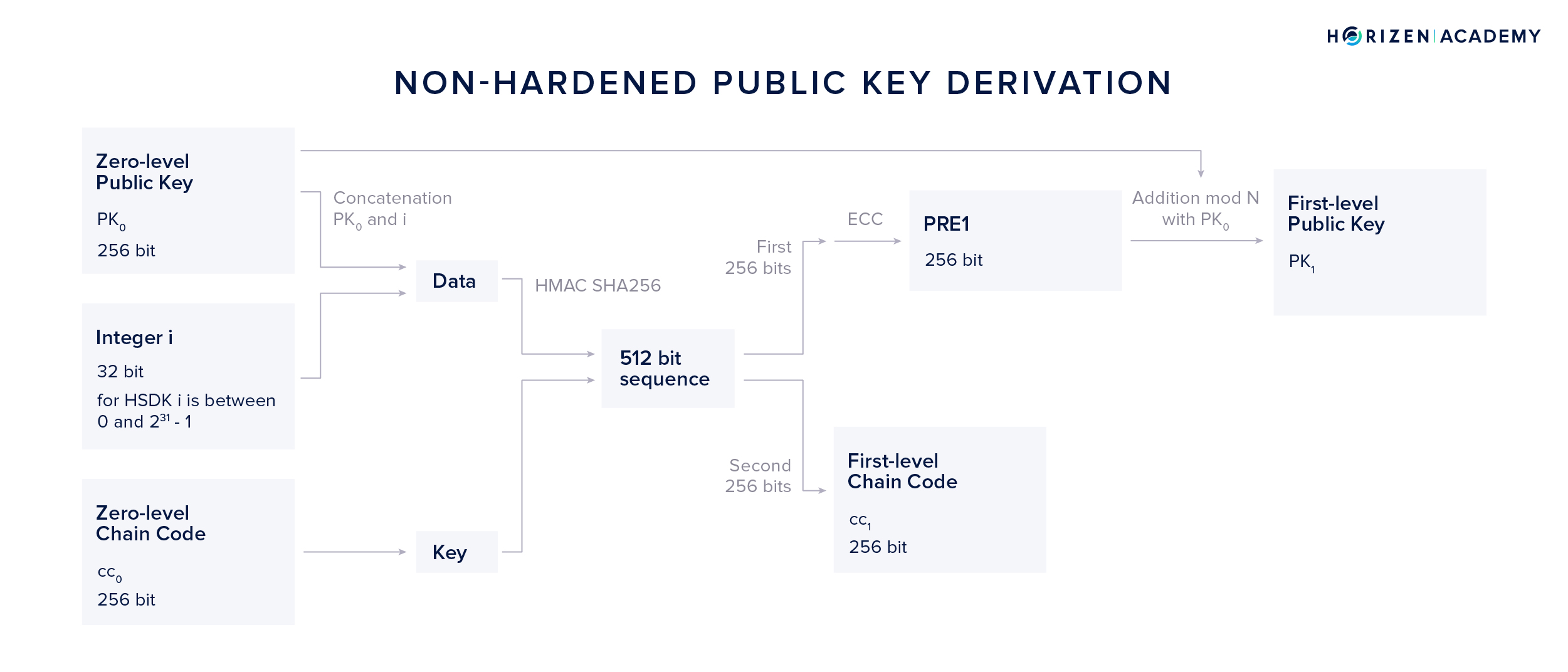

The concatenation of \(PK_0\) and i is used as data and \(cc_0\) as our key. Again, the resulting 512-bit output is split into two parts of 256 bits.
The first 256 bits are used as an input to the ECC module, producing an intermediary result we call \(PRE_1\). Applying the addition module N together with our zero-level public key \(PK_0\) we get a first level public key \(PK_1\) without having to touch \(sk_0\) at all.
Spending funds received at an address derived from a first-level public key yielded from this method works with \(sk_0\), as the first-level public key obtained using NPKD is equivalent to the first-level public key produced with the NSKD method.
Benefits of MultiSig
First, requiring several valid signatures diffuses the responsibility for keeping coins between several people. For instance, a married couple could have two individual private keys and two types of Multi Signature, or MultiSig, accounts. One account could act as a spending account, meaning either one of the two private keys can initiate a transaction. The other account could act as a savings account, which would require both keys to sign off before sending any outgoing transactions.
The spending account in this example would be called a 1-of-2 scheme: There are a total of 2 keys that can provide valid signatures and 1 of them is required to authorize a transaction. The savings account is a 2-of-2 scheme: 2 keys can provide a valid signature, and both are required to sign a valid transaction.
Second, you reduce the risk of losing access to your money or being hacked, by keeping funds in a MultiSig address and storing your keys in different locations. You could store your money in a 2-of-3 address and keep the three keys on your laptop, your phone and a hardware wallet. If one of those devices breaks, you can still access your funds and an attacker would need to compromise two devices to steal money. Hence, this setup eliminates single points of failure.
For larger amounts, 3-of-5 MultiSig schemes can be used. Casa offers solutions for 3-of-5 MultiSig schemes where they store one key for you. As long as you have access to two of your keys, you will always be able to recover your funds.
How MultiSig Works
The spending conditions of a UTXO are defined in the pubkey script. It essentially determines the verification process of the transaction.
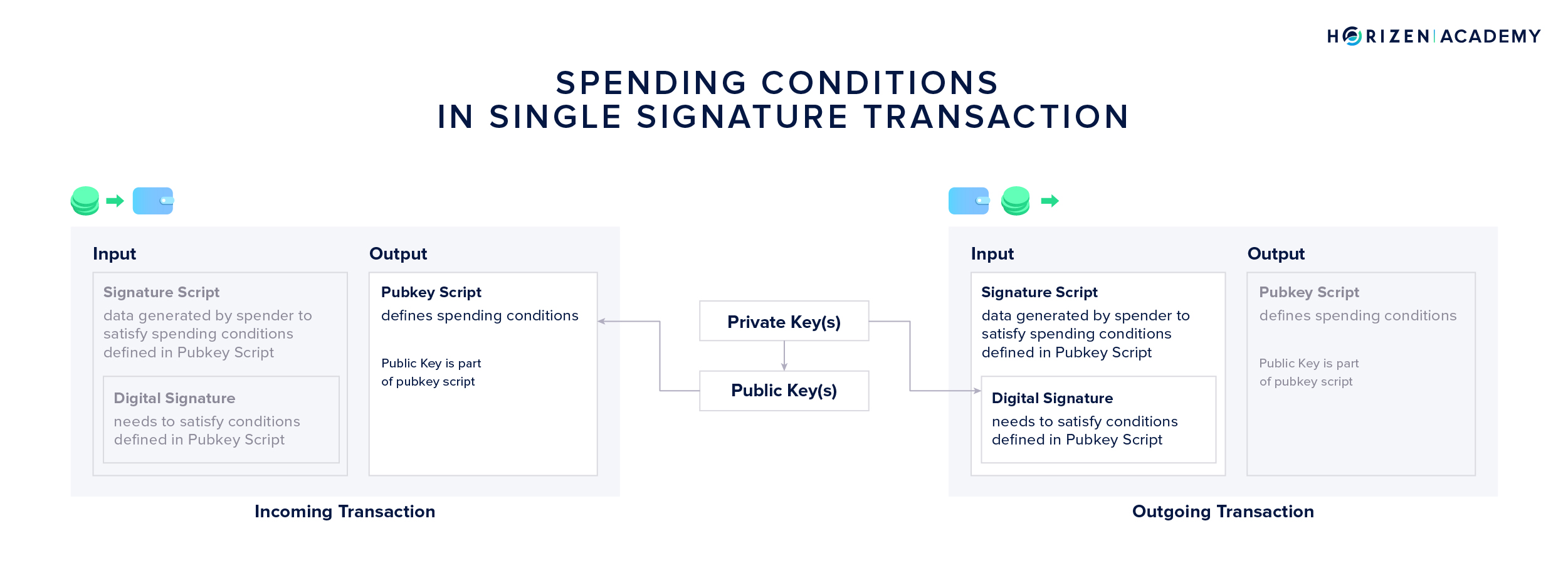
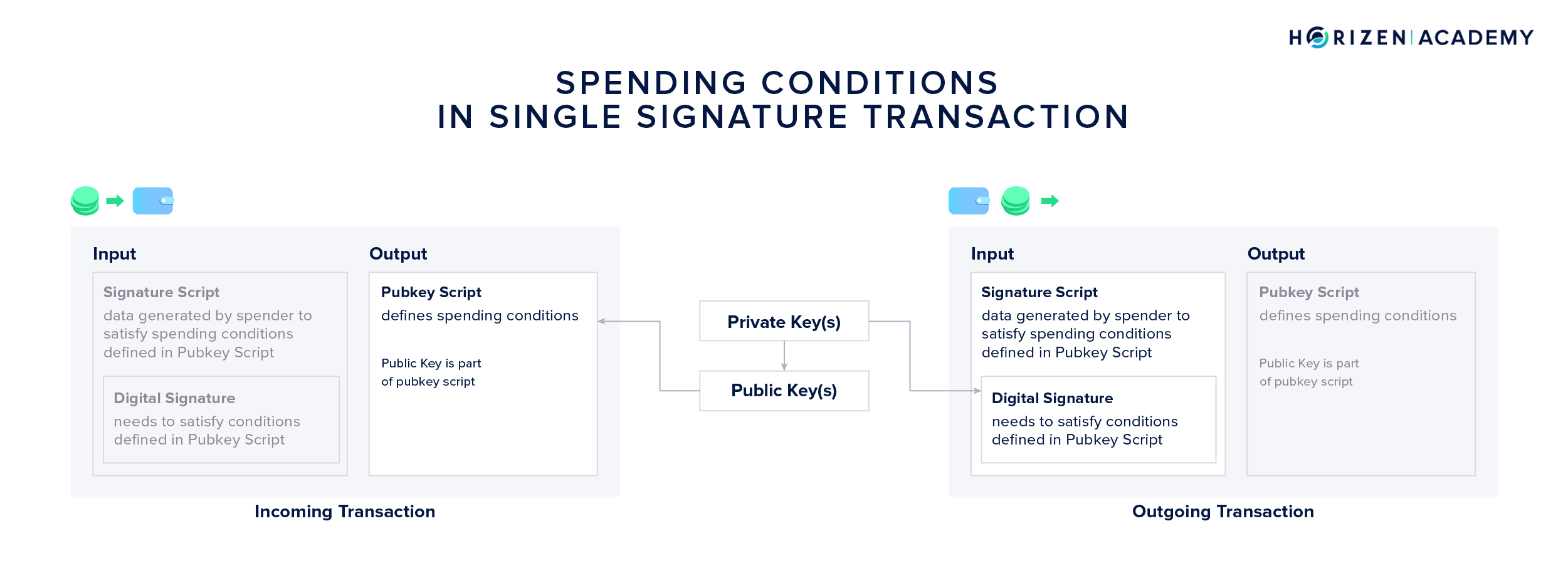
A regular “single-signature” transaction only involves the verification of one signature. The Pubkey Script is based on the public key that the money is sent to. The digital signature that can authorize spending of this money must be based on the corresponding private key.

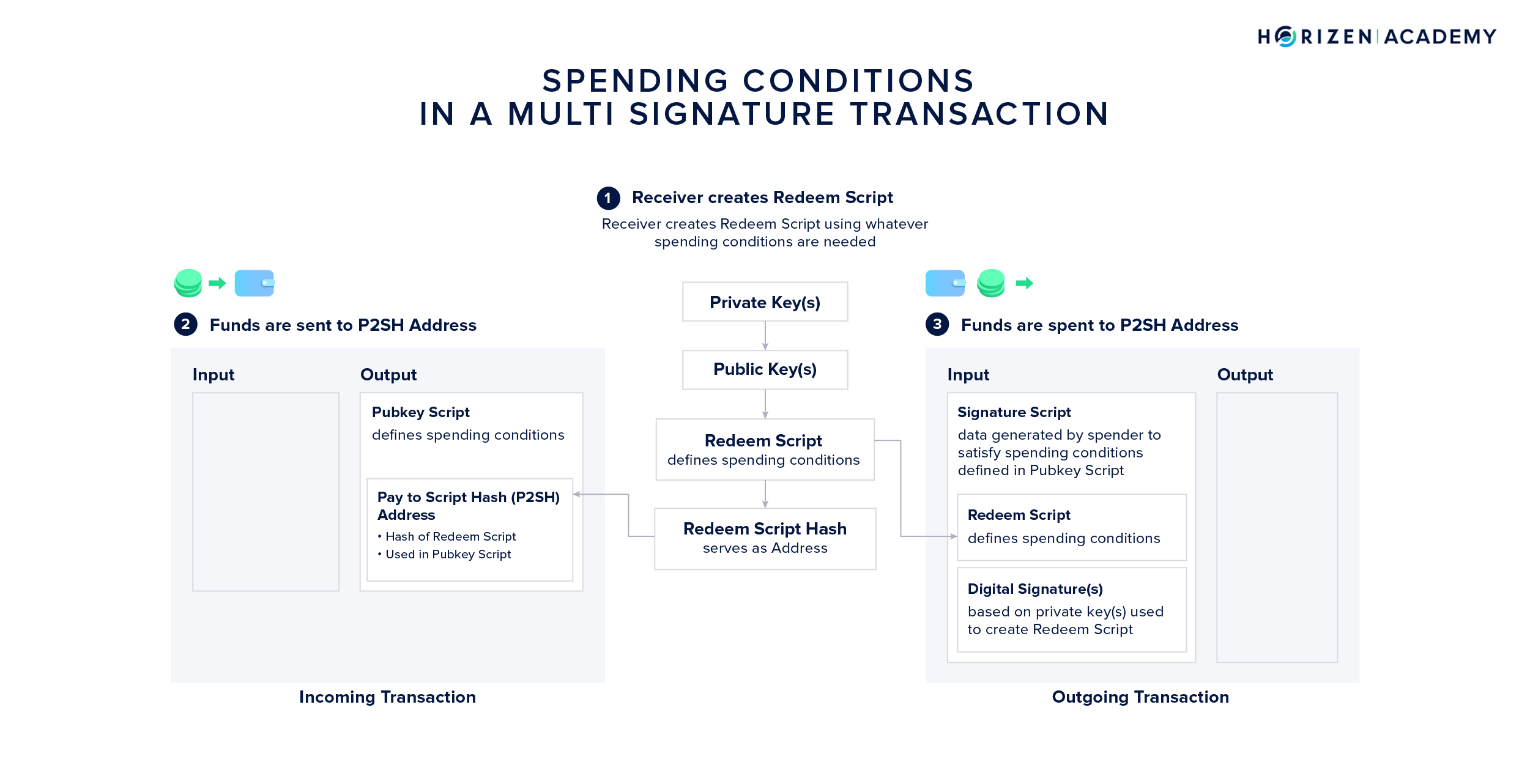
The spending conditions for MultiSig transactions are defined in a so-called redeem script. The hash of the redeem script functions as an address - a Pay to Script-Hash (P2SH) address. This address and the information contained in the redeem script is included in the pubkey script.
The redeem script of a multisig account entails the minimum number of signatures M that must be provided, as well as the set of keys N that can provide a valid signature. Redeem scripts can also involve other conditions, such as a time-sensitive component where funds are only spendable after a certain amount of time has elapsed.
Creating a Multi Signature Address
Imagine Alice bought ZEN on an exchange and wants to store them using a MultiSig setup. This means she needs to create a multi signature address and withdraw her funds to it.
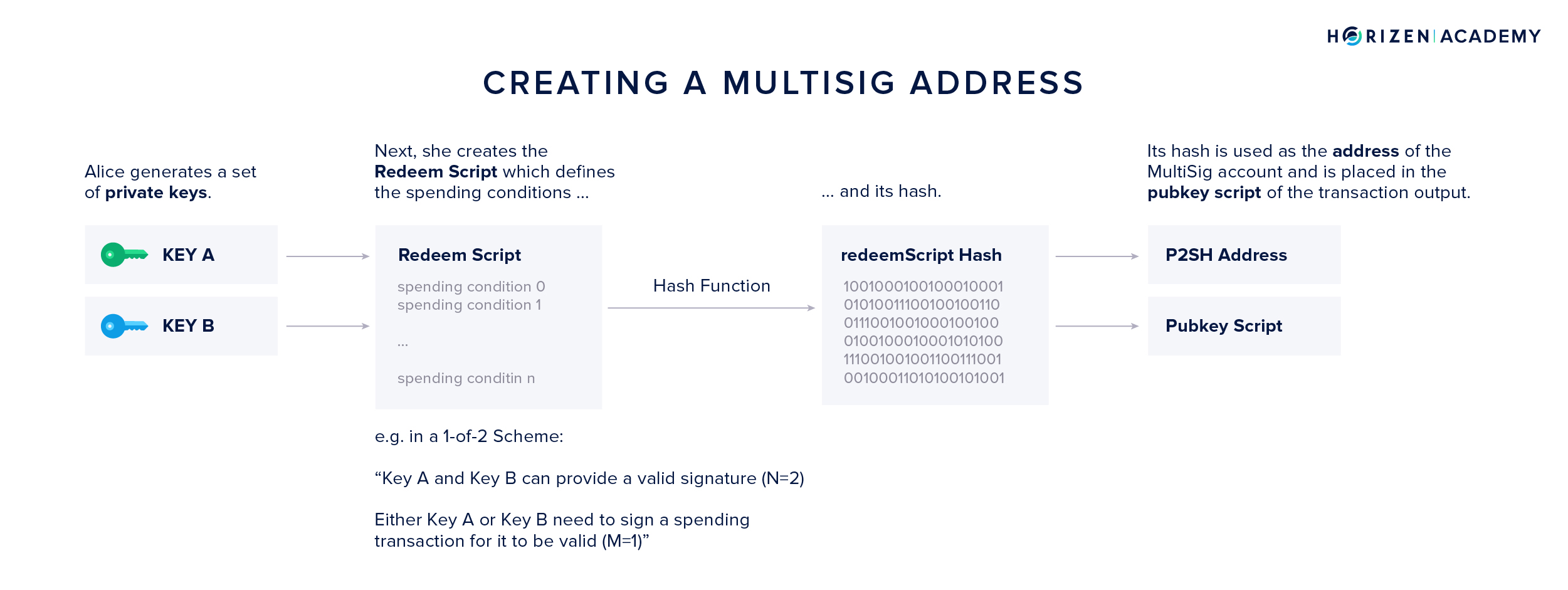
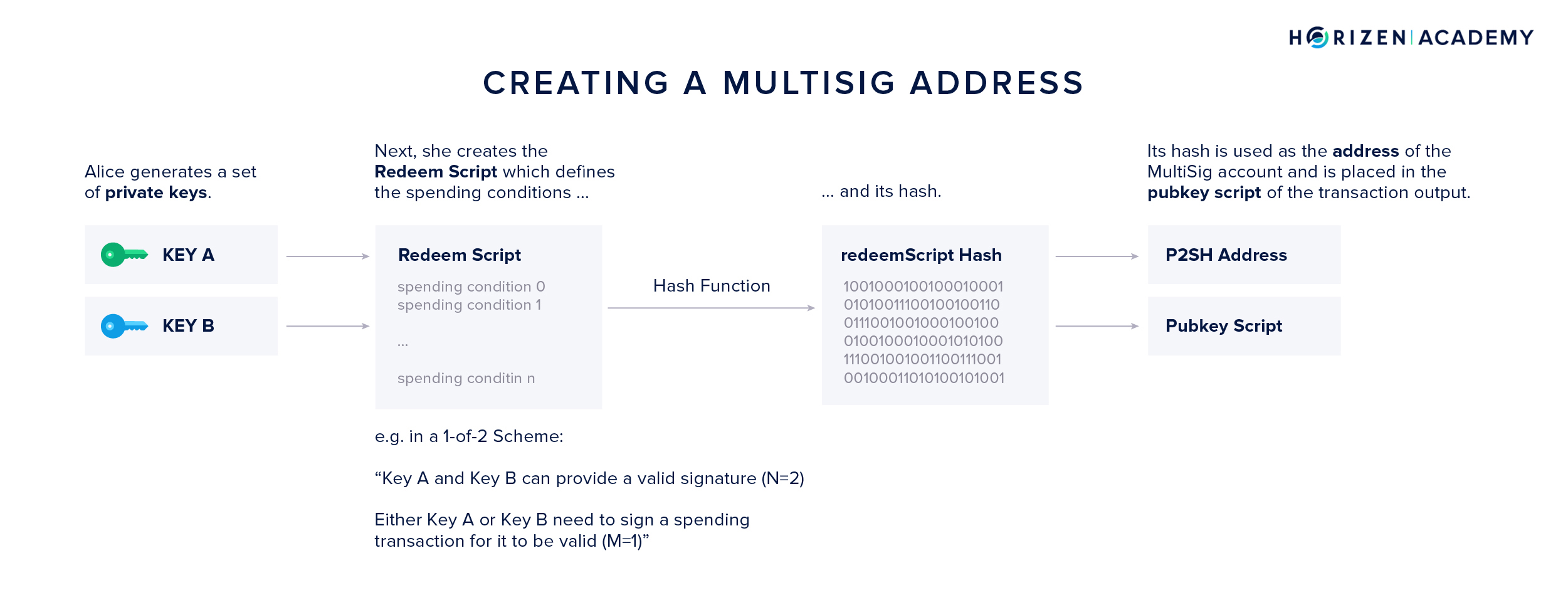
- First, she generates a set of private keys. The number of keys generated depends on the MultiSig scheme she wants to use. Let’s assume she wants to setup a simple 1-of-2 scheme, she generates two keys, either one of which is sufficient to authorize a transaction.
- Second, she creates the redeem script. It contains the information about the scheme used, 1-of-2 in Alice’s case, and the two public keys corresponding to the two private keys generated in the first step.
- Third, she hashes the redeem script. The hash of the redeem script is encoded into a P2SH address.
- Lastly, she withdraws her money from the exchange to her P2SH address.
There are several wallet implementations that offer multi signature support. This means, the wallet takes care of generating the keys and generating the redeem script. It also stores the unhashed redeem script. This is necessary because one needs to provide the redeem script to be able to spend the funds. The full redeem script only becomes part of the blockchain when Alice spends money from her MultiSig address for the first time. It is also possible to regenerate it on demand, based on the N defined public keys.
Spending from a Multi Signature Address
Verification of a transaction from a P2SH address involves checking if the redeem script hashes to the redeem script hash included in the UTXO’s pubkey script. In a second step, they will verify if the provided digital signature(s) satisfy the public key-based spending conditions included in the full redeem script.
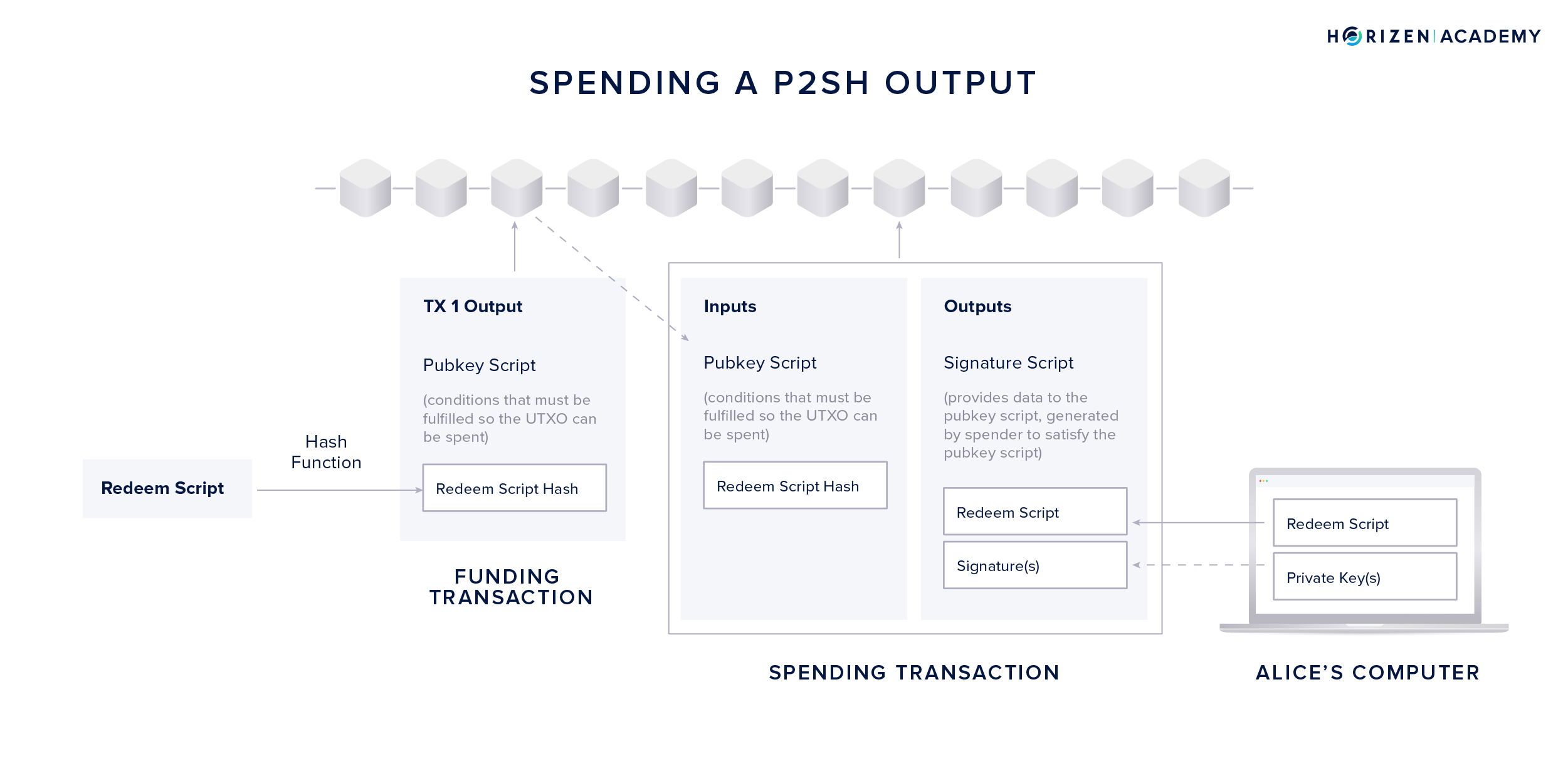

To spend from a P2SH address, the following steps are necessary:
- First, Alice will use the UTXO from the funding transaction and use it as an input to her spending transaction.
- Second, she places the full redeem script in the signature script part of the output.
- Third, she creates the required amount of digital signatures using her private keys. If we follow the example from above, she is using a 1-of-2 signature scheme and a single signatures created with either key A or B will suffice.
- Lastly, the transaction is broadcast to the network.
When the transaction is broadcast, the full redeem script becomes public. This means that observers will know the address being used is a MultiSig address and the different spending conditions. This is undesirable, as it compromises privacy. Two improvements are actively being worked on and are likely being implemented on various blockchains in the not-so-distant future.
MultiSig Improvements - Mast and Schnorr
The first is called Merkelized Abstract Syntax Trees (MAST). Here, the spending conditions are arranged in a merkle tree structure and the merkle root is included instead of the redeem script hash. By providing the fulfilled scrip conditions, redeemScripts, and the merkle path, a node can verify if a transaction is valid but does not learn anything about the other unfulfilled spending conditions.
The second improvement over traditional multi signature transactions comes with Schnorr signatures. They comprise two main aspects: signature aggregation and key pair concealment.
Signature aggregation allows several signatures to be combined into a single signature. This provides better privacy, as the aggregate public key is indistinguishable from a regular private key and an observer cannot link several public keys to one another. Schnorr signatures also come with increased efficiency. They produce much less data compared to an un-aggregated multi signature transaction.
Key pair concealment allows the modification of private keys and public keys.
“As a simplified example, a private key and its corresponding public key could be tweaked by multiplying both by two. The “private key x 2” and the “public key x 2” would still correspond, and the “private key x 2” could still sign messages that could be verified with the “public key x 2.” Anyone unaware that the original key pair was tweaked wouldn’t even see any difference; the tweaked keys look like any other key pair.” - Aaron van Wirdum
Using a multi signature scheme to secure your funds comes with a security-convenience trade-off:
- The more keys M are required to sign a transaction, the more cumbersome the process of spending money becomes.
- The larger the total number of keys N included in the MultiSig scheme, the more devices and backups need to be maintained.
- Alternatively, the overall security of the account is increased with a larger M. The difference between M and N is the number of keys a user can lose while being able to recover their funds. It is up to the individual user to determine if the added complexity is justified.
Summary
A wallet is a program that helps you manage your keys and create transactions easily. Your wallet looks at the blockchain to determine how much money you own by reviewing the transaction history. To send funds, it writes a transaction and signs it, meaning the wallet encrypts it with your private key
There are many ways to store your cryptocurrencies. Usually, there is a trade-off between convenience and security. The most important question is: where are the keys? A wallet is only a piece of software, an interface, that helps you perform the basic functions of cryptocurrencies: view your balance, create an address to receive funds, and create transactions to send funds.
With a hosted online wallet you are trusting a third party to handle your keys. You have the option to recover your password if misplaced, but there is always a significant third-party risk. If you don’t control your keys, you don’t control your funds!
With desktop, mobile, paper or hardware wallets you own the keys and nobody but yourself is responsible for keeping them safe. If your device breaks you have a mnemonic/recovery phrase to recover access to your money. The mnemonic phrase is a list of words that can be used to restore your private key. The mnemonic phrase is as sensible as your private key itself and if it gets in the wrong hands, your money can be stolen. This should not scare you, but make you cautious.
The first step in generating keys is to produce a random private key. Different sources for entropy generation can be used, and it’s advisable to use several sources of entropy for added security. Mnemonic phrases are generated by splitting the initial entropy into groups and mapping each group to a word.
There are different ways to derive a public key from a private key, the difference being the type of inputs. Most wallets today are hierarchical deterministic wallets that can create several key pairs from an initial entropy source. This is good for the user because they only need a single key to generate several separate accounts, even across different blockchains.
Several wallets support more advanced multi-signature transactions. They are classified as N-of-M schemes, where a minimum of N keys out of a set of M keys are needed to authorize spending. MultiSig wallets can be used to divide responsibility for storing money between several parties, increasing security. A single entity might also choose to set up a MultiSig account and store the keys in several locations.
We also looked under the hood of multi signature transactions. The conditions for spending from a multi signature account are defined in a redeem script. The hash of the redeem script is placed in the pubkey script of a transaction output. The pubkey script is always the location where spending conditions are defined. In order to spend money from such an account, you will need the full unhashed redeem script, as well as the minimum amount of required digital signatures.
